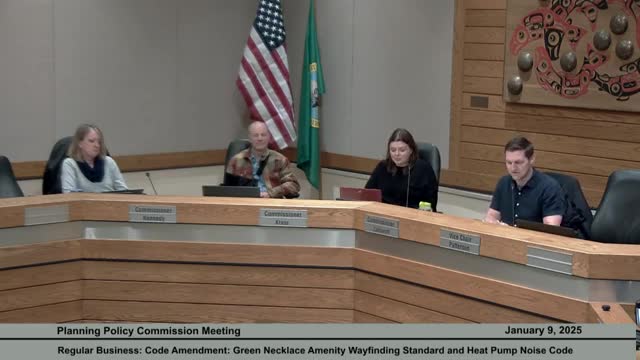Issaquah commissioners seek consistent city-branded wayfinding for Green Necklace trails
January 09, 2025 | Issaquah, King County, Washington
This article was created by AI summarizing key points discussed. AI makes mistakes, so for full details and context, please refer to the video of the full meeting. Please report any errors so we can fix them. Report an error »

The Issaquah Planning Policy Commission on Jan. 9 reviewed proposed code language requiring new and redeveloped properties adjacent to the Green Necklace to provide wayfinding signage to nearby parks and trail amenities. Staff presented draft standards on size, legibility and placement; commissioners pushed for consistency with existing city signage when signs point to city facilities.
Madeline Nelson, a planning intern, described the proposed requirement: developments adjacent to the Green Necklace amenity zone would provide clear, intuitive wayfinding that directs people to adjacent parks and trails. The draft standards call for a sign face of at least 3 feet tall with primary text at least 2 inches in height, durability, and placement that does not obstruct paths. Nelson said the Green Necklace plan (staff noted the public name remains "Green Necklace" though the project name is transitioning to "Creeks to Peaks") links parks and green spaces with pedestrian and bicycle infrastructure.
Why it matters: Commissioners said consistent signage helps users identify city facilities and follow trails across neighborhoods. Several commissioners suggested city-branded signs should be used where the sign points to city-owned facilities or the Green Necklace network; developers should be allowed to use their own branding for on-site, private-amenity wayfinding.
Consensus and staff direction: Commissioners broadly supported adding more detail to the draft standards so signs that point to city facilities match the city's existing wayfinding design (color, material, font and dimensions), while allowing developers to provide on-site or private-amenity signage that reflects their own branding. Assistant Planning Director Steven Badua summarized agreement that private developments may include branded signs for on-site features but when a sign directs to a city trail or park the city standard should apply. Commissioners and staff also discussed placement rules so city-branded signs are used at public trailheads or entry points whereas internal development signage may use a developer's design.
Technical details presented: staff showed an example bollard panel sign used in the Issaquah Parks wayfinding plan and proposed minimal but practical technical standards (3-foot face, 2-inch primary text). Staff said the requirement would apply to new development or redevelopment adjacent to mapped Green Necklace routes and would be implemented through development review.
Next steps: Staff will refine code language to explicitly require city-standard signage where a sign points to city-owned Green Necklace facilities, include placement guidance, and return with the revised draft for public review and hearings in 2025. Nelson said staff anticipates a public hearing in Q1 2025 and adoption by Q2 2025 as part of the broader code-amendment calendar.
Madeline Nelson, a planning intern, described the proposed requirement: developments adjacent to the Green Necklace amenity zone would provide clear, intuitive wayfinding that directs people to adjacent parks and trails. The draft standards call for a sign face of at least 3 feet tall with primary text at least 2 inches in height, durability, and placement that does not obstruct paths. Nelson said the Green Necklace plan (staff noted the public name remains "Green Necklace" though the project name is transitioning to "Creeks to Peaks") links parks and green spaces with pedestrian and bicycle infrastructure.
Why it matters: Commissioners said consistent signage helps users identify city facilities and follow trails across neighborhoods. Several commissioners suggested city-branded signs should be used where the sign points to city-owned facilities or the Green Necklace network; developers should be allowed to use their own branding for on-site, private-amenity wayfinding.
Consensus and staff direction: Commissioners broadly supported adding more detail to the draft standards so signs that point to city facilities match the city's existing wayfinding design (color, material, font and dimensions), while allowing developers to provide on-site or private-amenity signage that reflects their own branding. Assistant Planning Director Steven Badua summarized agreement that private developments may include branded signs for on-site features but when a sign directs to a city trail or park the city standard should apply. Commissioners and staff also discussed placement rules so city-branded signs are used at public trailheads or entry points whereas internal development signage may use a developer's design.
Technical details presented: staff showed an example bollard panel sign used in the Issaquah Parks wayfinding plan and proposed minimal but practical technical standards (3-foot face, 2-inch primary text). Staff said the requirement would apply to new development or redevelopment adjacent to mapped Green Necklace routes and would be implemented through development review.
Next steps: Staff will refine code language to explicitly require city-standard signage where a sign points to city-owned Green Necklace facilities, include placement guidance, and return with the revised draft for public review and hearings in 2025. Nelson said staff anticipates a public hearing in Q1 2025 and adoption by Q2 2025 as part of the broader code-amendment calendar.
View full meeting
This article is based on a recent meeting—watch the full video and explore the complete transcript for deeper insights into the discussion.
View full meeting
